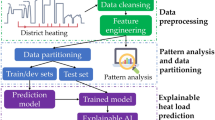Abstract
In this paper, we propose a real-time cooling load forecasting system in order to overcome the problems of the conventional methods. The proposed system is a new load forecasting model that hierarchically combines Support Vector Data Descriptions (SVDDs). The proposed system selects an optimal attribute subset by our cooling load forecasting system that enables real-time load data generation and collection. The system is composed of two layers: The first layer predicts the time slots in three representative forms: morning, midday and afternoon. The second layer performs specialized prediction of each individual time slot. Since the proposed system enables both coarse-and fine-grained forecasting, it can efficient cooling load management. Moreover, even when a new time slot emerges, it can be easily adapted for incremental updating and scaling. The performance of the proposed system is validated via experiments which confirm that the recall and precision measures of the method are satisfactory.



Similar content being viewed by others
References
Cover, T., Thomas, J.: Elements of information theory. WILEY, (1991)
Dong B, Cao C, Lee S (2005) Applying support vector machines to predict building energy consumption in tropical region. J Energy and Buildings 37(5):545–553
Erman, J., Mahanti, A., Arlitt, M.: Internet traffic identification using machine learning. In: 2006 IEEE Global Telecommunications Conference, pp. 1--6 (2006)
Fleuret F (2004) Fast binary feature selection with conditional mutual information. J Machine Learning Research 5:1531–1555
Haida T, Muto S (1994) Regression based peak load forecasting using a transformation technique. J IEEE Trans on Power Systems 9(4):1788–1794
Hall, M.: Correlation-based feature selection for machine learning. In: PhD Diss., Department of Computer Science. Waikato University, Hamilton, NZ (1998)
Han, J., Kamber, M.: Data mining: concept and techniques, Morgan Kaufmann Publishers, 2nd Ed., (2007)
Lee, H., Song, J., Park, D.: Intrusion detection system based on multi-class SVM. In: Lecture Notes in Artificial Intelligence, pp. 511--519 (2005)
Leung M, Norman C, Lai L, Chow T (2012) The use of occupancy space electrical power demand in building cooling load prediction. J of Energy and Buildings 55:151–163
Li, X., Ding, L., Li, L.: A novel building cooling load prediction based on SVR and SAPSO. In: 2010 International Symposium on Computer Communication Control and Automation, pp. 528--532 (2010)
Li Q, Meng Q, Cai J, Yoshino H, Mochida A (2009) Applying support vector machine to predict hourly cooling load in the building. J Applied Energy 86(10):2249–2256
Machine Learning Lab in The University of Waikato, http://www.cs.waikato. ac.nz/ml
Ok V (1992) A procedure for calculating cooling load due to solar radiation: the shading effects from adjacent or nearby buildings. J Energy and buildings 19(1):11–20
Rodgers J, Nicewander W (1988) Thirteen ways to look at the correlation coefficient. The American Statistician 42(1):59–66
Senjyu T, Takara H, Uezato K, Funabashi T (2002) One-hour-ahead load forecasting using neural network. J IEEE Trans on Power Systems 17(1):113–118
Seok I, Lee J, Moon B (2006) Hybrid genetic algorithms for feature selection. J IEEE Transactions on Pattern Analysis and Machine Intelligence 26(11):1424–1437
Sharifi M, Okhovvat M (2012) Scate: A scalable time and energy aware actor task allocation algorithm in wireless sensor and actor networks. ETRI Journal 34(3):330–340
Song K, Baek Y, Hong D, Jang G (2005) Short-term load forecasting for the holidays using fuzzy linear regression method. J IEEE Trans on Power Systems 20(1):96–101
Sun, Y., Li, J.: Iterative RELIEF for feature weighting. In: Proceedings of the 23rd International Conference on Machine Learning, pp.913--920 (2006)
Suykens J, Vandewalle J (1999) Least squares support vector machine classifiers. Neural Processing Letters 9(3):293–300
Vapnik V (1995) The nature of statistical learning theory. Springer-Verlag, New York
Vapnik V (1998) Statistical learning theory. John Wiley, New York
Xuemei, L., Jin-hu, L., Lixing, D., Gang, X., Jibin, L.: Building cooling load forecasting model based on LS-SVM. In: 2009 Asia-Pacific Conference on Information Processing, pp. 55--58 (2009)
Xunsheng, J.: Monthly power load predicting by WT and LS-SVM. In: 2011 Third International Conference on Measuring Technology and Mechatronics Automation (ICMTMA), pp. 640--643 (2011)
Yao Y, Lian Z, Liu S, Hou Z (2004) Hourly cooling load prediction by a combined forecasting model based on analytic hierarchy process. J Thermal Sciences 43(11):1107–1118
Yu J, Lee H, Im Y, Kim M, Park D (2010) Real-time classification of internet application traffic using a hierarchical multi-class SVM. J KSII Transactions on Internet and Information Systems 3(5):859–876
Yu J, Lee H, Kim M, Park D (2008) Traffic flooding attack detection with SNMP MIB using SVM. J Computer Communications 31:4212–4219
Acknowledgments
This work was Development of Smart Plant Safety Framework based on Reliable-Secure USN(10035310-2010-35), Development of the Integrated Environment Control S/W Platform for Constructing an Urbanized Vertical Farm(10040125-2011-199) funded by the Ministry of Knowledge Economy, and Development of USN/WoT Convergence Platform for Internet of Reality Service Provision(13ZC1130).
Author information
Authors and Affiliations
Corresponding author
Rights and permissions
About this article
Cite this article
Yu, J., Lee, BB. & Park, D. Real-time cooling load forecasting using a hierarchical multi-class SVDD. Multimed Tools Appl 71, 293–307 (2014). https://doi.org/10.1007/s11042-013-1412-1
Published:
Issue Date:
DOI: https://doi.org/10.1007/s11042-013-1412-1




